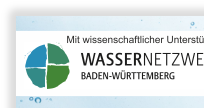The predominant microbial lifestyle in most aquatic ecosystems is the biofilm where microorganisms settle in multispecies communities at solid/water interfaces. While hydrodynamic largely dictates available substratum, initial settlement as well as growth of biofilm, the influence is not unidirectional: further development of these microbial cities shapes strongly their adjacent physical and chemical surrounding. These mutual interactions between flow-biofilm-sediment have important consequences for a variety of biofilm functions to impact the morphology of lotic and lentic waters as well as water quality and ecological health of the aquatic ecosystems (Gerbersdorf & Wieprecht 2015).
Within the framework of this workshop, biofilms and their interaction with flow and sediments were experimentally investigated in flumes by means of various methods. In particular, it should be made clear to what extent data obtained on different scales and with different methods can be brought together.
As a kick-off event, a public symposium with lectures for the introduction to the different topics took place at the University of Stuttgart, Institute for Modelling Hydraulic and Environmental Systems (IWS), on the morning of 12 June 2018. Further information in the PROGRAMME.
During summer, biofilms were cultivated at the Hydraulic Laboratory of the University of Stuttgart. In September 2018, the biofilms were analyzed by using the following methods:

- Digital Microscope, Magnetic Particle Induction (MagPI), Molecular Fingerprinting, Rheometry: Department of Hydraulic Engineering and Water Resources Management, University of Stuttgart
- Particle Image Velocimetry (PIV): Institute for Hydrodynamics, KIT
- Optical Coherence Tomography (OCT): Engler-Bunte-Insititut, Water Chemistry and Water Technology, KIT
- Hyperspectral Imaging: MPI for Marine Microbiology, Bremen
- Topographic Scanning: Institute for Environmental Sciences, University of Koblenz-Landau
After evaluation of the obtained data, a third meeting of the involved working groups took place at the University of Stuttgart on 13 February 2019 in order to discuss the different measuring methods. The synopsis of the applied measuring methods showed a high potential to better understand the interactions at the interface flow – biofilm – sediment.
The workshop series was organized by Dr. Sabine Gerbersdorf and Kaan Koca (Institute for Modelling Hydraulic and Environmental Systems, Department of Hydraulic Engineering and Water Resources Management, University of Stuttgart).
The results of the workshop have been published in a review article in 'Water Research':
Gerbersdorf et al. (2020): Exploring flow-biofilm-sediment interactions: Assessment of current status and future challenges
Origin of photos: Above: biofilm in a flume of the Institute for Modelling Hydraulic and Environmental Systems, University of Stuttgart (from Gerbersdorf & Wieprecht 2015, Geobiology, © B. Skodic); at the bottom right: Michael Wagner (Engler-Bunte-Institut, KIT) during the OCT measurement in Stuttgart (© U. Scherer).


